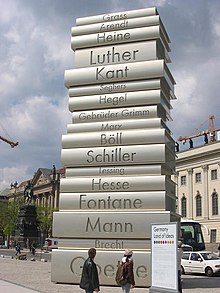
Back تاريخ الكتب Arabic বইয়ের ইতিহাস Bengali/Bangla Història del llibre Catalan Boghistorie Danish Buchgeschichte German Historia del libro Spanish Liburuaren historia Basque Kirjojen historia Finnish Histoire du livre French Գրքի պատմություն Armenian

The history of books became an acknowledged academic discipline in the 1980s. Contributions to the field have come from textual scholarship, codicology, bibliography, philology, palaeography, art history, social history and cultural history. Its key purpose is to demonstrate that the book as an object, not just the text contained within it, is a conduit of interaction between readers and words. Analysis of each component part of the book reveals its purpose, where and how it was kept, who read it, ideological and religious beliefs of the period, and whether readers interacted with the text within. Even a lack of evidence of this nature leaves valuable clues about the nature of that particular book.
The earliest forms of writing were etched on stone slabs, transitioning to palm leaves and papyrus in ancient times. Parchment and paper later emerged as important substrates for bookmaking, introducing greater durability and accessibility. Across regions like China, the Middle East, Europe, and South Asia, diverse methods of book production evolved. The Middle Ages saw the rise of illuminated manuscripts, intricately blending text and imagery, particularly during the Mughal era in South Asia under the patronage of rulers like Akbar and Shah Jahan. Prior to the invention of the printing press, made famous by the Gutenberg Bible, each text was a unique handcrafted valuable article, personalized through the design features incorporated by the scribe, owner, bookbinder, and illustrator.[1]
The invention of the printing press in the 15th century marked a pivotal moment, revolutionizing book production. Innovations like movable type and steam-powered presses accelerated manufacturing processes and contributed to increased literacy rates. Copyright protection also emerged, securing authors' rights and shaping the publishing landscape. The Late Modern Period introduced chapbooks, catering to a wider range of readers, and mechanization of the printing process further enhanced efficiency.
The 20th century witnessed the advent of typewriters, computers, and desktop publishing, transforming document creation and printing. Digital advancements in the 21st century led to the rise of e-books, propelled by the popularity of e-readers and accessibility features. While discussions about the potential decline of physical books have surfaced, print media has proven remarkably resilient, continuing to thrive as a multi-billion dollar industry. Additionally, efforts to make literature more inclusive emerged, with the development of Braille for the visually impaired and the creation of spoken books, providing alternative ways for individuals to access and enjoy literature.
- ^ Pearson, David (2011). Books As History: The Importance of Books Beyond Their Texts. London: The British Library and Oak Knoll Press. p. 23. ISBN 978-0-7123-5832-3.
© MMXXIII Rich X Search. We shall prevail. All rights reserved. Rich X Search